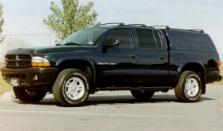Forums
Forum Tools
|
 |
03:35:45 - 12/24/2024
General Dakota Board
| From | Message |
MoltenRedDak
Dodge Dakota
JOIN HERE
2/08/2005
21:15:52
|
 Subject: Something that might apply to the 545rfe Subject: Something that might apply to the 545rfe
IP: Logged
Message:
My '04 CC 4X4 with a 4.7 and 545rfe has about 2k miles on it. I've noticed on cold mornings when I go to back out of the garage, the transmission doesn't want to seem to engage reverse right away. This also happens when I leave work on a cold day and shift into drive. I found this document on the GTO site where GM explains how electronic transmissions engage. I'm wondering if this description also applies to what I'm experiencing with the 545rfe?
Here is the document (sorry its kind of long):
Info - Engagement Time of Electronically Controlled Transmissions in General Motors Vehicles (Garage Shifts, Park to Reverse, Neutral to Drive, Neutral to Reverse, Park to Drive, Delayed Engagement) #03-07-30-007A - (Nov 4, 2003)
Engagement Time of Electronically Controlled Transmissions in General Motors Vehicles (Garage Shifts, Park to Reverse, Neutral to Drive, Neutral to Reverse, Park to Drive, Delayed Engagement)
2000-2002 Chevrolet Camaro
2000-2004 Chevrolet Corvette
2000-2002 Pontiac Firebird
2004 Pontiac GTO
2000-2004 All Light Duty Trucks
2003-2004 HUMMER H2
with 4L60-E (RPO M30) or 4L65-E (RPO M32) Automatic Transmission
This bulletin is being revised to add model years and models. Please discard Corporate Bulletin Number 03-07-30-007 (Section 07 - Transmission/Transaxle).
Park/Neutral to Reverse or Drive (commonly called garage shift) engagement times may be different from what many customers might be accustomed to, especially if they have recently traded for a General Motors' vehicle.
Normal Park/Neutral to Reverse or Drive engagement time will be in the vicinity of one (1) second if the automatic transmission fluid (ATF) is above 0°C (32°F) . When the ATF is colder than 0°C (32°F), the engagement time will become longer the colder the transmission fluid. A time limit factor cannot be placed on proper engagement times because the factors that affect transmission operation are many.
At the moment of engine start, for economy and emission requirements, the transmission line pressure is maintained at low levels. This allows a lower cold idle engine RPM (the colder the oil is, the higher the energy level (engine torque output) required to pressurize the oil).
When the driver moves the shift lever from "Park/Neutral" to "Reverse" or any "Drive" range, the following actions must occur for the powertrain control module (PCM) to determine at what pressure to control the transmission line pressure.
The module will look at the following items:
The voltage readings of the engine coolant temperature sensor (ECT).
The voltage reading of the transmission fluid temperature sensor (TFT).
Whether or not air conditioning is requested.
Movement of the shift lever and controls engine RPM based on the gear position selected. The module will adjust the engine RPM in response to the torque requirements needed to increase transmission line pressure.
When the module determines the status of the above items, the module will apply the appropriate signal to the PWM pressure control solenoid, thereby controlling the application of the required clutch(s) depending on the driver's selection.
Controlling transmission apply pressures allows the transmission to engage in a smooth manner, thus reducing the potential of abrupt/harsh engagement of the transmission.
All of the above actions happen very quickly; however, the resultant time interval may be approximately one second.
When determining if shift times are excessive, the exact conditions that the vehicle was in at the time the extended garage shift occurred must be duplicated. The following are several possible conditions.
Was the vehicle outside or in a heated garage?
What was the temperature of the environment at the time of the occurrence?
Length of time the vehicle sat unused, such as overnight or a weekend, etc.? A vehicle that has been driven to the service facility cannot be tested for this concern because the transmission, the engine oil and the coolant are no longer at the temperature they were when the customer experienced the condition.
No attempts to repair should occur unless the condition can be duplicated under the conditions the customer experienced.
© Copyright General Motors Corporation. All Rights Reserved.
|
BigblueQC
GenIII


2/09/2005
05:50:12
|  RE: Something that might apply to the 545rfe RE: Something that might apply to the 545rfe
IP: Logged
Message:
you will also notice it won't shift into overdrive right away when you get up to that speed either. And it sounds like you know have a jet engine under the hood as you are initially drive down the road the first time. Both exoected in our trans, fluids just need to warm up. The roar/jet sound is the fan spinning more than normal. Do some searching here on the website on your model trans, I think you will find what is happenening common and no cause for alarm. Of course, take it to a dealer you trust and see what they say to, I'm no mechanic, just an owner who has dealt with the same things. 123,000 miles later, stills drives like brand new
2002 QC 4x4 Sport Plus, 4.7L, auto, Patriot Blue, Tire & Handling group,
Heavy Duty Service group, Leer cap w/out windows, Mopar Step bars and roof rack, Rhino liner in bed and on step bars, Pace Edwards Power Tailgate lock
3.55 rear, 4-wheel anti-lock brakes, all possible fluids are AMSOIL
|
| | P 1 |
|
Post a reply to this message:
Username Registration: Optional
All visitors are allowed to post messages
|
|



